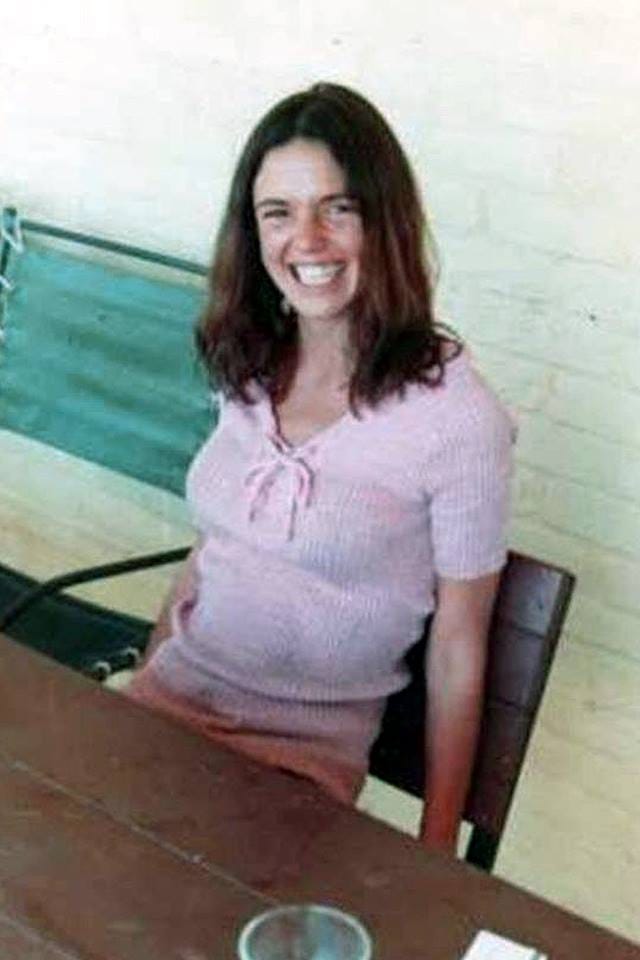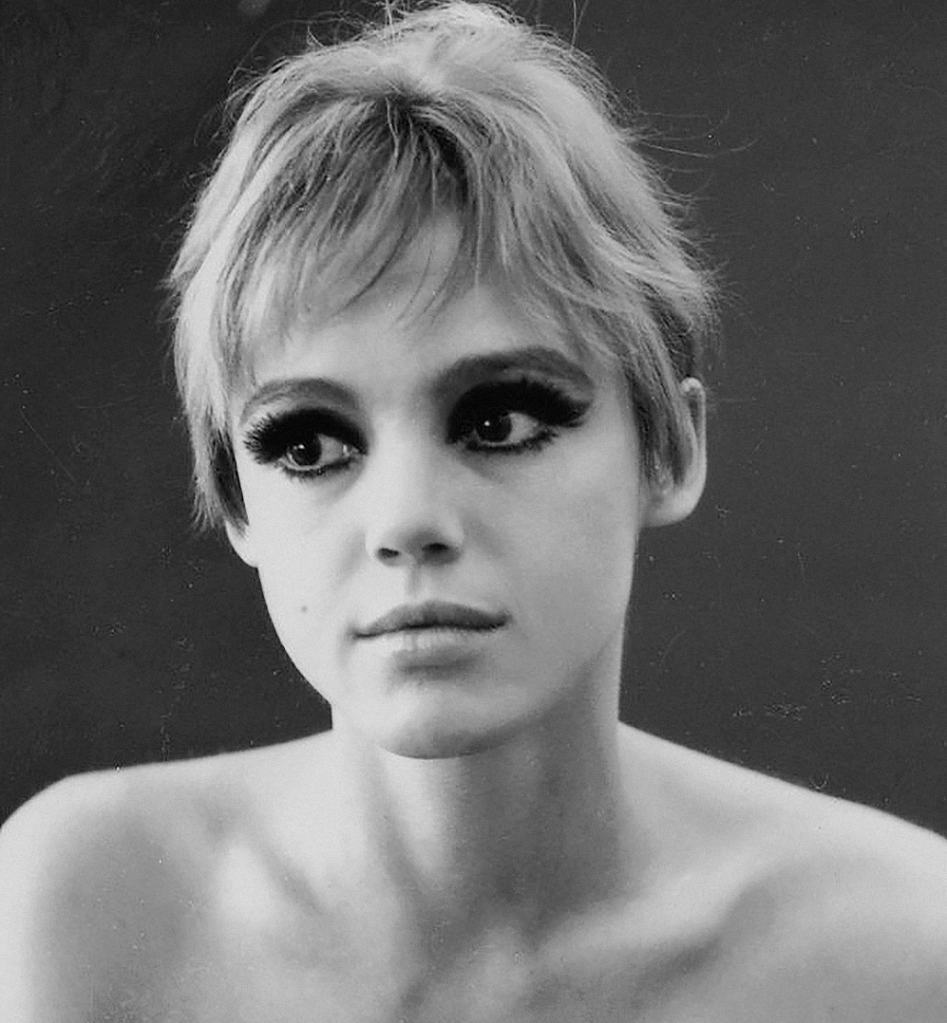EDIE SEDGWICK
Model, muse, Superstar.
(1943 – 1971)

My travels through the Vintage Interweb never cease to amaze me; I think it’s amazing, the things you stumble on that you’ve never heard of. My man, Koop Kooper, once shared an article on his stellar Lounge Life Magazine about artists achieving fame through their associations. A picture from this article was used by Koop as the temporary header for his magazine and this image fascinated me. It was a photo of Andy Warhol and his entourage in New York in the mid-1960’s. Included in the photo was a captivating girl with large eyes, dimples and short, bleached blonde hair. A visit to the article at artsy.net told me that the girl’s name was Edie Sedgwick. I had to look her up. Now, check this out…
Edith Minturn Sedgwick Post was born April 20, 1943 in Santa Barbara the seventh of eight children. Her family tree? Well, it’s…worth noting, let’s say. Her family can be traced back to Massachusetts in colonial times. Her seventh great-grandfathers were Robert Sedgwick (1611 – 1656), an English colonialist and Jesse de Forest (1576 – 1624) who was the leader of a group of Walloon Huguenots who fled Europe and helped found New Amsterdam or New York. There is a Walloon Settlers Memorial monument in Battery Park in Manhattan.
Her great-great-great-grandfather was Theodore Sedgwick (1746 – 1813), an attorney and politician who was a Supreme Court Justice and the 4th Speaker of the House of Representatives. Theodore – a friend of President John Adams – famously won an early “freedom suit” when he took the case of Elizabeth Freeman, a black slave who had fled her master. Having won her freedom, Elizabeth remained with the Sedgwicks, working for a wage and becoming a cherished member of the family; when Elizabeth died, she was buried in the Sedgwick family plot. Theodore’s daughter, Catherine Sedgwick (1789 – 1867) wrote about Elizabeth and the freedom suit and became one of America’s first significant female novelists. Another of Edie’s great-great-great-grandfathers was William Ellery (1727 – 1820), a Chief Justice of the Supreme Court and a signer of the Declaration of Independence.
Later came Edie’s great-great-grandfather Robert D. Weeks (1795 – 1854) who was only a banker – and a founder of the New York Stock Exchange. Other descendants from this era include many power players including shipping magnates, priests and others who were prominent in New England at the time. Many were buried in the Sedgwick Pie, the family burial plot in Stockbridge so named for its unique shape.
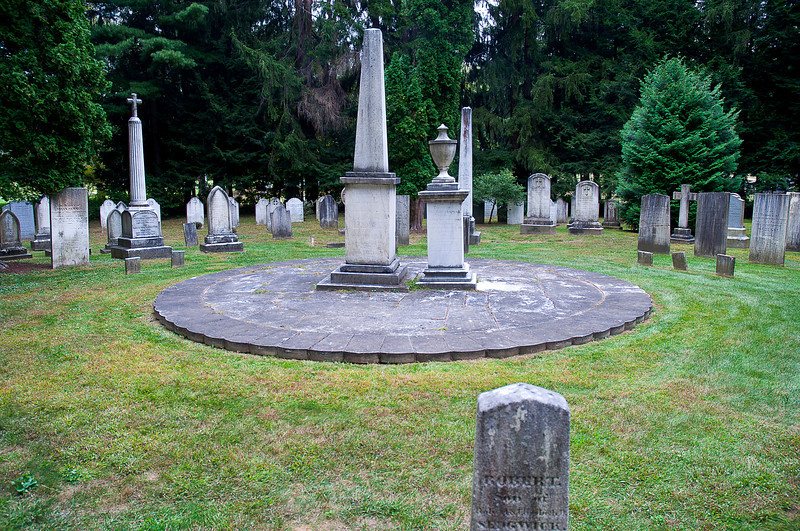
Edie’s great-granduncle was Robert G. Shaw (1837 – 1863), an officer in the Union Army during the Civil War. Shaw commanded the first all-black unit in the Army and was a strong supporter of equal treatment and equal pay for his troops. Shaw had been inspired by family friend Harriet Beecher Stowe’s anti-slavery book Uncle Tom’s Cabin. During the second battle of Fort Wagner in the summer of 1863, Shaw lead his men against the Confederates but was killed. Shaw’s body was left among those of his fallen troops and he was buried with them in a mass grave. When efforts began to bring Shaw’s remains home, his father wouldn’t hear of it. As Shaw had been a crusader for emancipation, it was felt fitting that he should rest with his troops. Robert Shaw was portrayed by Matthew Broderick in the Oscar-winning film Glory (1989).

Henry Dwight Sedgwick III (1861 – 1957) was a Massachusetts lawyer and author who, with his first wife, Sarah May Minturn, had four children including Edith Minturn who died in 1901 on the day of her birth. Henry’s second-oldest son, Robert, would have a son who was the father of actress Kyra Sedgwick. Henry’s youngest son, Francis Minturn, was Edie’s father.
Edith Minturn Stokes (1867 – 1937), Edie’s grand-aunt, was a socialite and an “artistic muse” who married Isaac Newton Phelps Stokes in Quebec. Isaac was a prolific architect and published works on the history of Manhattan Island. Grand-uncle Lockwood de Forest was a popular interior designer during the Gilded Age. His furniture was purchased by the likes of Andrew Carnegie and Mark Twain. Lockwood eventually retired to Santa Barbara where he died in 1932.
Edie’s cousins include members of the family of famed Finnish mid-century industrial designer Eero Saarinen and Canadian Holly Sedgwick who is Kyra Sedgwick’s half-sister and the mother of Canadian-Japanese singers and actors. Lastly, there is socialite and film actress Rosamond Pinchot. While still a teenager, Rosamond was a brief sensation on Broadway and the press named her “the loveliest woman in America”. Her lone film appearance was as Queen Anne in 1935’s The Three Musketeers and she was married once, to a former husband of actress Kay Francis. Rosamond Pinchot committed suicide in 1938; she was 33.
You could argue, then, that there was already a certain climate of expectation waiting for Edie when she was born and given a venerable family name. There was plenty to live up to – but also plenty to rebel against. Despite all of the wealth and all of the status, Edie and her siblings suffered harsh treatment during their childhood. Their father, who was called “Fuzzy”, brutalized the children and imposed strict measures on their upbringing while he carried on affairs and supposedly molested Edie who later suffered from mental illness and anorexia.
On April 20, 1964, Edie turned 21 (click here for pics from that very day) and received an $80,000 trust fund from her grandmother. With this windfall, she escaped her home life and fled to New York City to pursue a career in modelling. There she met Andy Warhol who was absolutely captivated by her. Edie became Andy’s muse and fast friend when she joined his troupe and began frequenting Warhol’s studio, The Factory. Andy began to put Edie in his experimental films and this combined with her mainstream modelling and her increasing visibility lead to her being referred to as “The Girl of the Year”, “The It Girl” and “Youthquaker”. Significantly, a term was popularized by the duo to specifically describe Edie Sedgwick; “Superstar”. This may sound like nothing to us today but there was a time when this phrase was not common parlance. Proof of this exists in a fascinating clip from The Merv Griffin Show on which Andy and Edie describe the term to Merv.
At this time, Edie adopted a striking look; her slender figure was adorned in black leotards or mini dresses and she wore large chandelier earrings and heavy eye make-up. She cut her hair short and sprayed it silver to match Warhol’s. The two regularly “made the scene” and showed up together at all the hip affairs. Then, while she was living at the Chelsea Hotel, she met and developed a friendship with Bob Dylan.
This part of Edie’s life is heavily disputed by many people, most notably Dylan himself. Dylan perceived immediately that Sedgwick was wasting her time with Warhol. Bob and others began to encourage Edie to break away from him. An idea was apparently floated that Edie and Bob would make a mainstream film together and Sedgwick felt this would be her ticket out of Warhol’s avant-garde world. Edie aligning herself with the down-to-earth Dylan – who contrasted starkly with Warhol’s posturing – seemed to irk Andy who began to freeze Edie out. There are additional claims that Edie’s relationship with Zimmy became romantic and, as a result, she eventually had to end a pregnancy. Dylan denies that their relationship was ever romantic and this scenario does seem unlikely.







What is certain though is that Andy Warhol felt slighted by Edie’s desire to go mainstream and he developed a disdain for both Edie and Bob. Warhol seemed to feel betrayed by Edie wanting to actually get paid for her work, as opposed to “working” for Warhol unpaid. With Andy cutting her adrift and her finances evaporating, Edie learned that Dylan had suddenly married and the feeling of isolation intensified. Indications are that Edie’s continued drug abuse was to blame for people distancing themselves from her and it had a deleterious effect on her physical and mental health. She had been abused – to some extent, at least – by her father and had suffered the tragic loss of two of her beloved brothers, both of whom suffered from mental illness and one who committed suicide. A sustaining career had not materialized and her mentor and supposed benefactor, Warhol, had turned his back on her. Perhaps she had been in love with Bob Dylan who’s personality and career path were becoming divergent from Edie’s. Then, in March of 1967, a film project emerged that Edie hoped could finally provide what she had been lacking.
Ciao! Manhattan would be an underground film a step above Warhol’s bonkers avant-garde movies. It would tell Edie’s own tale and be half-a-documentary about her life as part of The Factory. As it was initially conceived, the film charted Edie’s life as part of Warhol’s world and as part of the fashionable drug scene in Manhattan. However, during filming, Edie’s health deteriorated and the movie was riddled with budget and other problems and was shelved. The director was John Palmer who would go on to a career as a second unit director and camera operator who worked on films like Firefox (1982) and The World is Not Enough (1999). In 1970, he and Edie would resume filming with a new premise. Edie would portray a version of herself, Susan Superstar, who would look back on her life as a “celebutante” in the mid-’60’s. New footage was shot at the run-down “Lucky” Baldwin estate in Arcadia, California with a cast of non-actors…and Isabel Jewell. I would love to know the story of how Jewell – a Hollywood veteran who had appeared in films like Lost Horizon (1937), Gone With the Wind (1939) and Bernardine (1957) – ever ended up in Ciao! Manhattan playing Edie’s mother. And keep this in mind; before this film would eventually premiere in Amsterdam on July 19, 1972, Jewell would be dead from suicide, having overdosed on barbiturates.

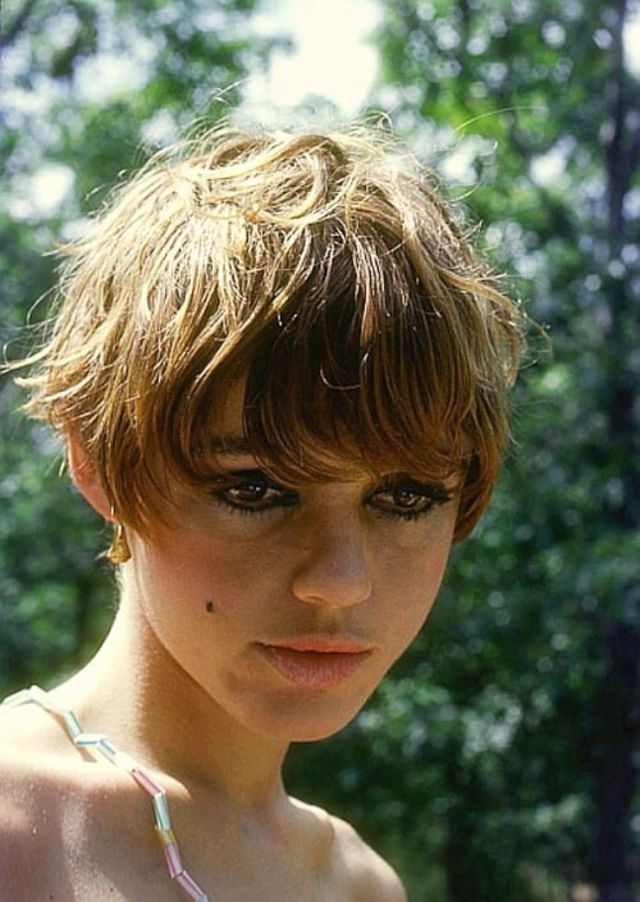





During filming, Edie had to be hospitalized in a psychiatric ward mainly due to her drug abuse. She was released into the custody of John Palmer and his wife as she was determined to finish the film. In the new footage, Susan and Edie both are spiralling from the effects of drug use. Susan lays around all day asking for her lunch while she tells her story to the redneck who has picked her up hitchhiking and brought her home. As Susan – topless through most of the film – tells her story, the 1967 footage is shown cleverly by way of flashback. Edie gave lengthy audio interviews at the time that are overheard during the old footage.
We love to talk about low-budget films here at Your Home for Vintage Leisure, films that may unintentionally make you chuckle and roll your eyes but we like them because we are fans and not critics – you know the ones. But Ciao! Manhattan is not like that. This movie is deadly serious. The clunky work of the non-actors aside, this is a fascinating film. I suppose if you went into it blind, you’d simply be unimpressed with it and turn it off. But this is why it can help to know something about a film before you watch it. If you know the story of Edie Sedgwick’s life, this movie becomes a compelling, harrowing film and a harsh document, a convicting tale of excess and the way that the world of “celebrity” can chew up and discard people. In Ciao! Manhattan, you are watching someone deteriorate before your eyes. The lack of dark eye make-up aside, I am floored by how different Edie looks in this film compared to her modelling heyday.
As mentioned, while making this film in the summer of 1970, Edie had been admitted to Cottage Hospital in Santa Barbara and entered their psychiatric treatment facility and there she met fellow patient Michael Post. Perhaps with Michael, Edie found true love and the two were married a year later on July 24, 1971.
Shooting on Ciao! Manhattan had wrapped some months earlier and the film was finally completed.
For the first months of her marriage, Edie was able to stop abusing drugs and alcohol and she and Michael enjoyed a brief life of sobriety.
As the winter of ’71 began, John Palmer and his crew prepared Ciao! Manhattan for release. The film was slated for a February premiere. The filmmaker’s excitement and positivity, though, would be short lived and they were dealt a final, decisive blow.
By the late fall of ’71, Edie was drinking and using drugs again. On November 15, 1971, Edie Sedgwick went to a fashion show at the Santa Barbara Museum. She attended a party afterwards where she drank. She called her husband to pick her up and, as they drove home, she expressed to him uncertainty regarding their marriage. Michael gave Edie her prescribed medication before she went to sleep. At 7:30 the following morning, Post awoke and turned to his wife. She was dead. She was 28.
The coroner ruled her death “undetermined/accident/suicide”, attributing “probable acute barbiturate intoxication”. Edie Sedgwick was not buried with her storied ancestors in the Sedgwick Pie but instead rests in Oak Hill Cemetery in Ballard, California.
The death of Edie Sedgwick gave Ciao! Manhattan a notable release. However, the film enjoyed little success in its time and today is not much more than a curiosity. Watching the film now, though, is difficult. Juxtaposing the two Edies in the film is jarring and drives home the idea that the story of Edie Sedgwick is one of the more tragic in the annals of celebrity history. My unapologetic opinion of drug abuse is that users make a decision. Once upon a time they made a decision and every day they continue to abuse drugs they make that decision. A conscious decision to put themselves in harm’s way. The clean-living athlete stricken by cancer would gladly change places with an addict who, it could be argued, can avoid sickness simply by not using. “Simply”, I said. I also understand that for many it is often not simple. Addiction can have a crippling death grip on a person. When the root of the problem is mental illness, a person can almost not be blamed for seeking release in drugs.


Edie Sedgwick had it all. She came from a long line of overachievers. At her birth, what she could achieve knew no bounds. Who knows what demons possessed her father, Francis, or what sickness lead him to abuse his children and alter their paths, effectively reducing the number of things they could achieve. From her early teenage years then, Edie may have been doomed.
Not finding love and acceptance in her home, she was forced to look for it elsewhere. Without a foundation of healthy self-esteem and loving, supporting parents, Edie searched for surrogates in many places. Her neediness was palpable and went unfulfilled. Is Edie Sedgwick to blame for her failure to avoid drugs and get clean? Yes. And, emphatically, no.
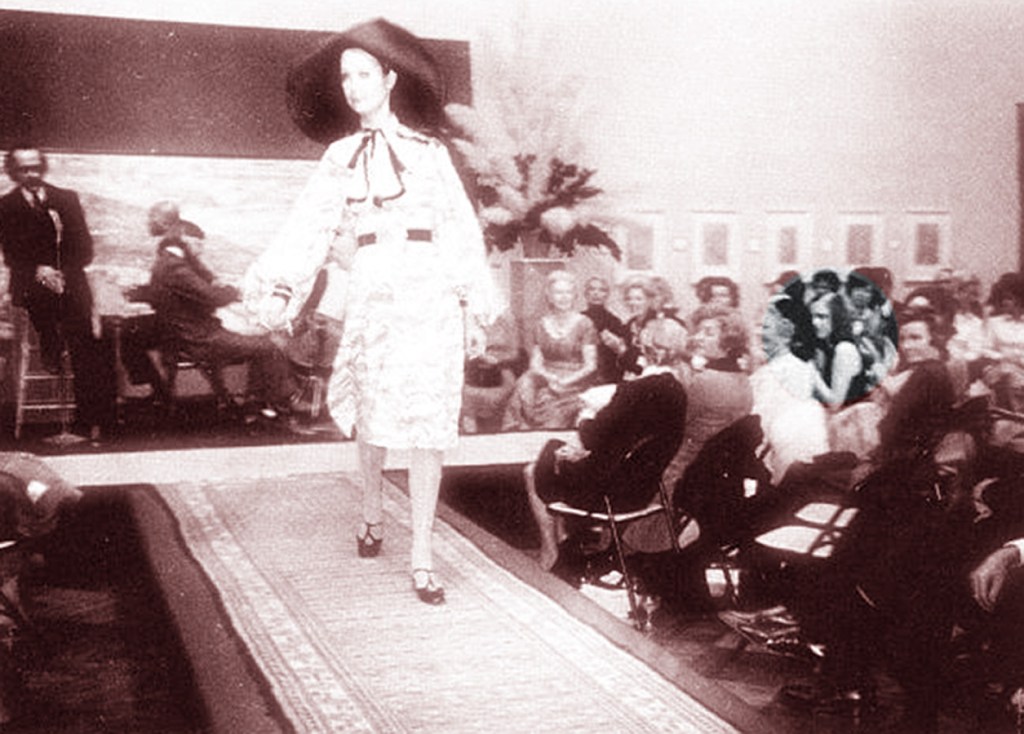
For me, the appeal of Edie lays in a “damsel in distress” scenario. As a writer and a dreamer, I can conceive of a young man who may have encountered Edie in her prime and sensed her pain. This guy sees “an angel with a broken wing” and he draws near to her, shows her kindness, gentleness and love and takes her away from her torment.
I said at the outset that I am surprised that I had never heard of Edie Sedgwick or her story. This ties in with a quote of mine I often use; “I love Old Hollywood. And then I think of what it did to…”. Whether its Judy Garland – who first prompted my quote – or Carole Landis, who’s story is another compelling tragedy it pained me to report on, the fleeting nature of popularity and celebrity is ruthless. So many people are broken and the embrace of celebrity can prop them up for a time. But when the tide turns and trends or styles change, many are left behind. And if they are not equipped within themselves to move on, it can be devastating.
Andy Warhol turning his back, Bob Dylan throwing up his hands, fashion trends constantly oscillating; all these things and others conspired to deal Edie blows she could not withstand. I’d never heard of her because she was 50 years ago and celebrity moves on. But a story like hers, a cautionary tale, should be told and told often. Never buried or forgotten.
She makes me incredibly sad but that face.
Ciao, baby.
Check These Out: Further Studies
Edie: American Girl – Jean Stein with George Plimpton (1982) // This is considered the essential book on Edie and reignited interest in her in the 1980’s. Pick it up here. Apparently you should avoid David Dalton’s book Edie, Factory Girl.
Factory Girl (2006) // Film directed by George Hickenlooper. An interesting movie as long as you understand that it takes many liberties with Edie’s story, particularly where Bob Dylan is concerned. Not a bad place to start, though. Sienna Miller does very well as Edie as does Guy Pearce as Andy Warhol. Also with Jimmy Fallon, Mena Suvari, Illeana Douglas and Mary-Kate Olsen and with an appearance by Edie’s husband, Michael Post as a cab driver. Dylan wanted to sue because of how he was depicted by Hayden Christensen. To avoid litigation, the character is never named in the film but is apparently “Billy Quinn”. Not only inaccurate, Lou Reed called the film “one of the most disgusting, foul things I’ve ever seen” made by “a bunch of whores”. Don’t hold back, Lou. Check it out here. They say there’s no good roles for women in Hollywood; where was Miller’s nomination for this?
Ciao! Manhattan (1972) // For reasons I’ve already illuminated. Absolutely fascinating with an intriguing soundtrack with tunes from Richie Havens and John Phillips. There’s a sparkling print for viewing here if you can access it.
“Edie (Ciao, Baby)” (1989) by the Cult // I loved this song and this album back in the day but didn’t realize this song was about Sedgwick until I was researching her. Funny but the song still resonated with me when it came out because of its tale of a beautiful tragic girl. I had one in my life at the time and named a character in a short story Edie. Ian Astbury and Billy Duffy seem to understand Edie Sedgwick. Recorded in British Columbia, doncha know. Check out the video here. “Always said you were a Youthquaker, Edie / A stormy little world shaker / Oh, Warhol’s darling queen, Edie / An angel with a broken wing…Oh, caught up in an endless scene / Yeah, paradise a shattered dream / Oh, wired on the pills you took, Edie / Your innocence dripped blood, sweet child“
Edie.pink // I utilized this website much while writing this. Not sure how active it still is but the person running this site presents photos and text as if she is Edie; “here’s me on my 21st birthday”. This level of devotion, while all consuming, is interesting and actually understandable considering the subject. It’s also understandable when you think of how much easier life would be if you were only into one thing or person as opposed to me, all over the place. Some pics here I haven’t seen anywhere else.


